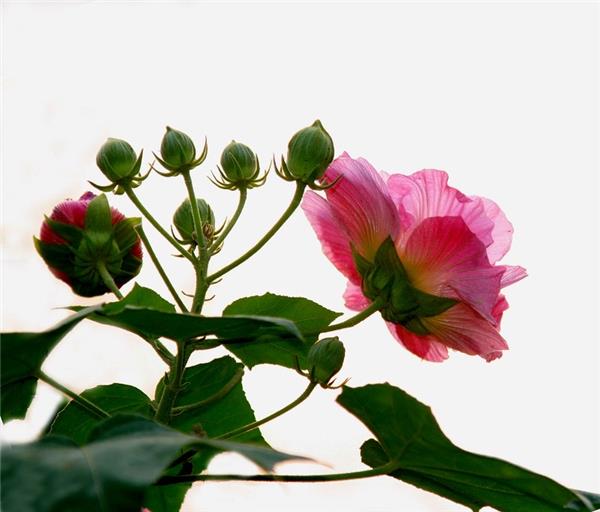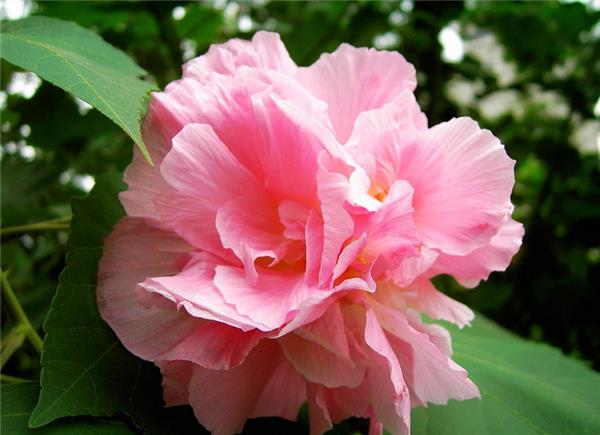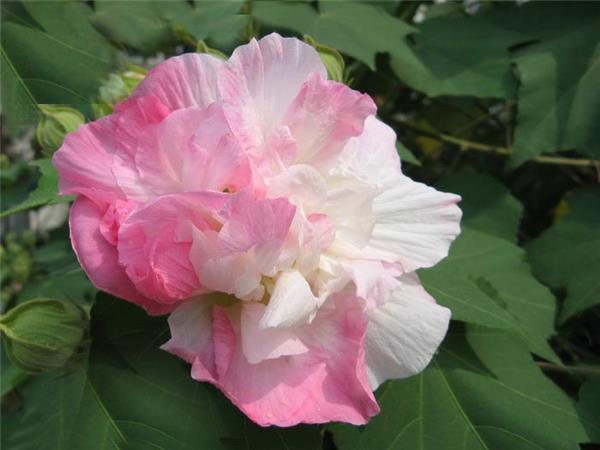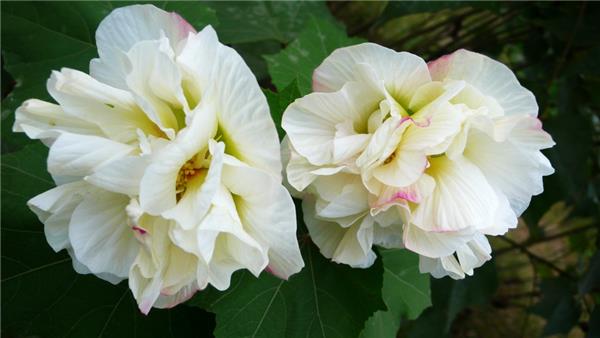[when will hibiscus bloom] matters needing attention in hibiscus culture
Hibiscus flowers are characterized by elegant and dusty Corolla, fresh and plain colors, often see hibiscus flowers in bloom, will make people have a kind of calm feeling, physical and mental comfort, so hibiscus flowers are very suitable for breeding.

I. the shape characteristics of hibiscus flowers
Flowers solitary in axils of terminal leaves, pedicels ca. 5-8 cm long, proximally articulate; bracteoles 8, linear, 10-16 mm long, ca. 2 mm wide, densely stellate woolly, base connate; Calyx campanulate, 2.5-3 cm long, lobes 5, ovate, acuminate; flowers white or reddish at first, then crimson, ca. 8 cm in diameter, petals subrounded, 4-5 mm in diameter, outside hairy, base bearded Staminal column 2.5-3 cm long, glabrous; style branches 5, sparsely hairy.
2. Varieties of hibiscus flowers
Hibiscus flowers are divided into water hibiscus and dry hibiscus according to their growing environment. According to the color is divided into: red hibiscus, white hibiscus, yellow hibiscus and five-color hibiscus, in addition, there are rare and valuable varieties: drunken hibiscus. The color of drunken hibiscus will change three times a day, so drunken hibiscus is also called three drunken flowers.

Third, the propagation mode of hibiscus flower.
Cuttings are widely used. After the winter flowers have withered, they are pruned and cut in December, or the branches are cut into 15 to 20 meters in length between March and April of the following year. They are inserted into about 1/3 of the length of the branches, keep moist after insertion, and take root after January. It is easy to survive, grow fast, and blossom that year. Hibiscus cultivation should be carried out before leaves in early spring.
Ramet propagation: it is not a very large plant at the initial stage of growth, but it can be cultivated without soil mass, and can be cultivated with some ratoon soil. If cultivated in the growing period, it is necessary to bring soil masses, otherwise it is not easy to survive. After planting, it should be thoroughly watered once, and then properly watered according to the soil moisture to keep it moist.
Sowing and propagation: the ripe fruit was picked in November-December and sowed in March-April of the following year. The seeds were buried deep in the ditch, covered with soil and grass, and emerged in about 15 days. The seedlings can be planted in the nursery after raising seedlings for 1 year.
Striping propagation: from July to August, the branches were buried in the soil for more than one month, and the branches pressed in the soil took root. after one month, they could be cut off from the mother plant and survive the winter.

When will the hibiscus blossom
The hibiscus flower changes three times a day, pink in the morning, light red in the day, and dark red at dusk, and its delicate and beautiful appearance is often unforgettable; the second is its unique character of "resisting frost". This flower is in full bloom from the ninth to November of the lunar calendar, that is, late autumn, when the flowers wither, but it is proud of the frost. Therefore, Bai Juyi has a poem: do not be afraid of autumn without worries, water lotus flowers and trees are in full bloom.
Matters needing attention in the culture of hibiscus flowers
Soil: hibiscus likes warm, moist and sunny environment, slightly resistant to semi-shade, and has a certain degree of cold resistance. It is not strict with the soil, but it grows best in the rich, moist and well-drained sandy soil.
Moisture and temperature: it is necessary to maintain sufficient moisture in the growing season to ensure growth demand. Because of its poor cold resistance, it should be moved indoors in winter to ensure that the temperature is controlled at 0 ℃ to 10 ℃, so that it can sleep naturally.
Weeding: weeding needs to be done once a year in summer and winter, and topdressing for 2-3 times. Hibiscus flower bud is very slow, should not be exposed to direct sunlight, the light conditions are suitable.
Pruning: hibiscus is resistant to pruning, it can be trimmed and shaped according to the needs, and the withered branches and leaves can be cut into pieces to ensure the lightness. Pay attention to warm treatment in winter. And it is best to cultivate its plant shape into a shrub.
Diseases and insect pests: common red leaf mite is the most common pest, which can be sprayed with 73% propargite 3000 times or 20% dimethyl ether EC 1000 times. The harm of small green leafhopper and cotton leafhopper should not be underestimated, which can be sprayed with 5% carbaryl powder.

Breeding hibiscus flowers has many benefits and effects, so if after reading the above introduction, everyone has a good impression of hibiscus flowers, don't hesitate to breed one.
Related
- Wuhan Hospital Iron Tree Blooming Result Was Instantly Frightened by the Gardener Master
- Which variety of camellia is the most fragrant and best? Which one do you like best?
- What is the small blue coat, the breeding methods and matters needing attention of the succulent plant
- Dormancy time and maintenance management of succulent plants during dormancy
- Minas succulent how to raise, Minas succulent plant pictures
- What are the varieties of winter succulent plants
- How to raise succulent plants in twelve rolls? let's take a look at some experience of breeding twelve rolls.
- Attention should be paid to water control for succulent plants during dormant period (winter and summer)
- Watering experience of twelve rolls of succulent plants
- Techniques for fertilizing succulent plants. An article will let you know how to fertilize succulent plants.



